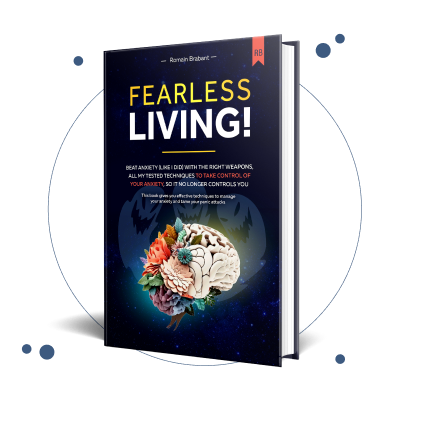
Building up your self-esteem is all about changing the way you see and talk to yourself. But before you can do that, you have to understand why you feel the way you do in the first place. This journey is about spotting old, negative patterns, standing up to your inner critic, and taking small, real-world steps to build confidence you can actually feel. This approach offers a clear, hopeful roadmap to easing anxiety and slowly, steadily rebuilding your sense of self-worth.
Understanding Where Low Self Esteem Comes From
If you’re wrestling with low self-esteem, it can feel like you're the only one. But you're far from alone. Research shows that a staggering 85% of people struggle with it at some point, making it an almost universal human experience. To get a handle on this, scientists often use tools like the Rosenberg Self-Esteem Scale (RSES), which is a trusted way to measure self-worth. It’s worth taking a look at some key research findings on self-esteem just to see how common these feelings truly are.
The goal here isn't to get stuck in the past. It’s about developing a kinder, more compassionate understanding of why you feel this way. Recognizing where the self-doubt comes from is the first, and honestly, the most important step toward making a real, lasting change.
The Cycle of Self-Doubt
Low self-esteem doesn't just show up one day. It’s usually the end result of a nasty cycle powered by past hurts, the constant pressure of social comparison, and that relentless inner critic. This cycle can keep you trapped in anxiety and self-doubt, making it feel like there's no way out. But there is a way out, and it starts with understanding the pattern.
- Past Experiences: Events from early in life, especially criticism from family, teachers, or friends, can stick with us. Those moments often become the core beliefs we carry about who we are.
- Social Comparison: In a world flooded with perfectly curated social media feeds, it's so easy to fall into the trap of measuring your real life against someone else's highlight reel. This habit is a surefire way to feel like you're not enough.
- The Inner Critic: This is that harsh voice inside your head that blows your flaws out of proportion and writes off your successes. It’s the narrator of your self-doubt story, and it keeps the whole cycle spinning.
This infographic breaks down how these three pieces feed into each other, creating a loop that just keeps hammering away at your self-worth.

As you can see, a negative experience from the past can wake up the inner critic. That critic then points to social media as "proof" that you don't measure up, which only strengthens that original negative belief.
Understanding this pattern is the key to dismantling it. You can't fight an enemy you don't understand. Recognizing this cycle gives you the power to interrupt it and begin to heal.
So many of these foundational wounds trace back to our younger selves. Looking at these connections can be a huge step toward healing. Learning about the inner child healing steps for anxiety and self-love can offer a way to mend those deep-seated beliefs. The good news is that once you see these patterns, you can start to break the cycle and build a new, more compassionate relationship with yourself.
How to Reframe Your Inner Dialogue
That relentlessly critical voice in your head? The one that whispers you’re not good enough after a small mistake or predicts failure before you even start? It can feel like your biggest enemy, constantly fueling anxiety and chipping away at your self-worth.
But what if you could change that conversation? Here’s the hopeful truth: you absolutely can. You can learn to reshape this inner dialogue, transforming your internal critic into a more supportive guide. This is a skill, and like any skill, it can be learned.
This whole process starts with a powerful technique called cognitive reframing. It’s not about slapping on a fake smile or ignoring reality. Instead, it’s about learning to catch those automatic negative thoughts (ANTs) in the moment and gently—but logically—question if they’re actually true.

Identify Your Automatic Negative Thoughts
The first real step is just noticing these thoughts when they pop up. ANTs are often lightning-fast and disguise themselves as unquestionable facts. You might catch one after a specific trigger, like getting some constructive feedback at work or saying something awkward at a party.
Imagine you miss a deadline. The ANT might immediately scream, "I'm a complete failure and can't do anything right." This is a classic example of a thought pattern that is not only unhelpful but also untrue.
These patterns often fall into predictable categories, and just understanding what they are is a huge step toward dismantling them. To see how these patterns work in more detail, you can explore the most common cognitive distortions that frequently undermine self-esteem.
The key is to recognize these thoughts without judging yourself for having them. You aren’t bad for thinking this way; these are just deeply ingrained mental habits. For now, just start labeling them when they appear: "Ah, there's that 'I'm a failure' thought again."
Question and Reframe the Narrative
Once you've spotted a negative thought, it's time to put it on trial. You don't have to accept it as fact. Instead, you can challenge its authority by asking a few direct questions.
- Is this thought 100% true? Is it really true that you can't do anything right? Can you think of any time you've ever succeeded at something?
- What's a more balanced perspective? A more accurate thought might sound like, "I missed this one deadline, which is frustrating, but it doesn't define my overall competence. I'll figure out what went wrong and adjust for next time."
- What would I tell a friend in this situation? You’d probably offer compassion and constructive advice, not harsh criticism. It’s time to extend that same kindness to yourself.
This simple questioning process interrupts the anxiety spiral. It creates just enough space for a new, more realistic narrative to form.
Here’s a quick look at how you can transform some common negative thoughts into something more balanced and constructive.
Practical Cognitive Reframing Examples
| Automatic Negative Thought (ANT) | Questions to Challenge It | Balanced Reframe |
|---|---|---|
| "I completely bombed that presentation. I'm so incompetent." | Was it really a total disaster, or did some parts go well? What's one thing I can learn from it? Am I defining my entire worth by one performance? | "That presentation wasn't my best, and I felt nervous. But I prepared, and I got my main points across. I'll ask for feedback and use it to improve for next time." |
| "They haven't texted back. They must be mad at me." | Is there any other possible reason they haven't replied? Are they busy? Do I have actual evidence they're upset? | "I haven't heard back yet, and that makes me a little anxious. But people get busy. I'll assume the best and focus on something else until I hear from them." |
| "I'll never be able to get out of debt. I'm a financial failure." | Is it true that it's impossible? What's one small, practical step I could take today? Is this thought helping me solve the problem or just making me feel helpless? | "My financial situation is challenging, but it doesn't make me a failure. I can create a budget, look for ways to increase my income, and take it one step at a time." |
As you can see, the goal isn't to pretend the negative feeling doesn't exist. It's about preventing that feeling from becoming your entire reality.
The goal isn't to erase negative feelings but to stop them from defining your reality. You are learning to separate your thoughts from your identity, which is a monumental step toward living with less anxiety.
Another powerful way to build on this is to practice self-love affirmations regularly. This helps reinforce the balanced, kinder perspectives you're working to build.
By consistently practicing this reframing technique, you gradually start to rewire your brain’s default settings. Bit by bit, you build an inner voice that offers hope and guidance instead of criticism, giving you the power to manage anxiety and truly improve your self-esteem from the inside out.
Build Lasting Confidence Through Small Wins
Real, solid self-esteem isn’t something you can just switch on. It’s something you build, brick by brick, with your own two hands. When anxiety has you convinced you're not capable of much, the single most powerful way to prove it wrong is to create tangible, undeniable evidence that you are.
This is where the hope is. It’s not in wishing you felt better, but in taking small, deliberate steps that show you what you're actually made of. A panic-free life is possible, and it begins with these tiny acts of courage.
The secret is to aim for tiny, achievable wins that build momentum. Low self-esteem loves overwhelming goals because they usually lead to paralysis, reinforcing that awful "stuck" feeling. So instead of a vague, massive goal like "get a new job," you break it down into the smallest possible first step.
Your only goal for this week might be to spend 30 minutes updating your resume. That’s it. It’s specific, it’s manageable, and it's something you can absolutely do. When you follow through, you get a small but potent dose of self-respect. You kept a promise to yourself.

Create a Positive Feedback Loop
Each small win you collect acts as a building block. Finishing that one small task doesn't just inch you closer to a bigger goal; it actually starts to recalibrate how you see yourself. You begin to shift your identity from "someone who procrastinates" to "someone who gets things done."
This kicks off a powerful positive feedback loop:
- Action leads to evidence: You complete a small task.
- Evidence leads to belief: You see concrete proof of what you can do.
- Belief leads to confidence: Your self-esteem grows, even if just a little.
- Confidence leads to more action: You feel more capable of taking the next small step.
This cycle is the engine for healing from anxiety. It gives you a practical, action-based way to dismantle the feelings of helplessness that anxiety feeds on. The aim is to stack up so much proof of your competence that your inner critic’s arguments just start to sound ridiculous.
Practice Competence in Low-Stakes Scenarios
Gathering this evidence doesn't always have to be tied to a major life goal. You can generate small wins in everyday life just by learning a new skill or nudging yourself slightly outside your comfort zone.
Think about these low-stakes opportunities to build proof:
- Learn a simple new skill: Spend an hour on YouTube learning three basic guitar chords or master a new recipe for dinner. The act of learning and successfully applying new knowledge proves to your brain that you are capable of growth.
- Practice assertiveness: The next time a barista gets your coffee order wrong, politely point it out. This isn't about creating a confrontation; it's about practicing speaking up for your needs in a situation where the outcome doesn't really matter.
- Use your body to build confidence: It’s incredible how much your posture can influence your mindset. Simple adjustments to how you carry yourself send powerful signals back to your brain. To dig into this, you can explore how to use power poses to reduce anxiety and build confidence.
Each of these small actions is like a deposit into your self-esteem bank account. They might feel minor on their own, but their cumulative effect is what forges lasting, resilient self-worth.
You are not defined by your feelings of anxiety or panic. By focusing on small, consistent actions, you prove to yourself, day by day, that you are a capable and competent person. This is how you build a foundation of confidence so solid that anxiety can no longer shake it.
Why Self-Care Is Essential for Self-Worth
The term "self-care" gets thrown around a lot, often bringing to mind images of bubble baths and face masks. And while there's nothing wrong with a good spa day, true self-care runs much, much deeper.
It's the active, ongoing practice of showing yourself, through your actions, that you are worthy of respect, kindness, and rest.
For anyone working to build up their self-esteem, this isn't a luxury—it's foundational. Self-care is the direct antidote to the anxiety-driven belief that you don't deserve a break or that your needs should always come last. It's how you stand up to that harsh inner critic who insists your worth is tied to how much you produce or how happy you make everyone else. It is a vital part of your healing journey.

This isn't just a personal battle, either. There's a massive cultural shift happening. The self-improvement market is on track to hit $64.6 billion for a reason: people are actively looking for ways to manage their mental health.
With an estimated 84% of US consumers now calling wellness a top priority, it's clear that building self-esteem is part of a much bigger movement toward holistic health. You can get more details on this growing trend from the Global Wellness Institute website.
Beyond the Basics: Meaningful Self-Care Practices
Okay, let's move past the clichés and get into the core practices that genuinely build resilience and self-worth. These aren't just one-off treats; they are consistent actions that send a powerful message to your subconscious: "I matter."
Here are a few meaningful ways to put that into practice:
- Set and Defend Healthy Boundaries: Honestly, this is one of the most powerful forms of self-respect out there. Saying "no" to something that would drain you isn't selfish. It's a clear declaration that your energy and time are valuable resources worth protecting.
- Protect Your Sleep Relentlessly: Sleep deprivation is fuel for anxiety and low self-esteem. Making 7-9 hours of quality sleep a non-negotiable is a fundamental act of caring for both your physical and mental health.
- Engage in Restorative Hobbies: Find activities that actually recharge you, not just distract you. This could be gardening, painting, or playing an instrument. The only rule is that you do it purely for the joy of it, with zero pressure to be productive.
By consistently choosing actions that honor your well-being, you are physically demonstrating your worth to yourself. This is how you begin to heal from anxiety and build a panic-free life from the inside out.
Solidifying Your Sense of Self
Beyond taking care of your physical and mental well-being, you can solidify your sense of worth through more reflective practices. A powerful exercise is writing a personal mission statement that clearly defines your values and purpose. Think of it as an internal compass that guides your actions and reinforces your identity, separate from what anyone else thinks.
Another potent tool is journaling. Learning about what journaling is and its benefits can give you a structured way to process your thoughts, celebrate small wins, and practice being kinder to yourself.
Each of these practices is an investment in your relationship with yourself, creating a stable foundation of self-worth that anxiety can't easily shake.
Navigating Setbacks Without Losing Progress
Building real, lasting self-esteem is a journey, not a destination. And let’s be honest, that path is almost never a straight line. You’re going to have tough days. Moments of self-doubt will creep in. You will face setbacks.
This isn’t just normal; it’s a non-negotiable part of the healing process. A bad day doesn't mean you've failed or erased all your hard work. It doesn't mean you're back at square one.
The biggest shift you can make is learning to see these moments not as a catastrophe, but as an opportunity. A difficult day isn't proof that you’re inadequate—it's just feedback. It’s your chance to practice the very skills you’re developing, especially self-compassion.
Embrace Self-Compassion Over Self-Criticism
When things go wrong, what’s your first instinct? For many of us, it’s to let that inner critic grab the microphone. We blame ourselves, get frustrated, and slide right back into those old, familiar patterns of negative self-talk.
The key to navigating these moments is to make a conscious, intentional choice to practice self-compassion instead.
Self-compassion simply means treating yourself with the same kindness you’d offer a good friend who was struggling. You wouldn't look a friend in the eye and call them a total failure for having a bad day, so why is it okay to say that to yourself?
When a setback hits, try this instead:
- Acknowledge the Pain: First, just validate your feelings without piling on judgment. Tell yourself, "This is really hard right now," or "I'm feeling discouraged, and that's okay."
- Remember Your Shared Humanity: Gently remind yourself that making mistakes is part of the human experience. Everyone struggles. You are not alone in this.
- Offer Yourself Kindness: Ask a simple question: "What do I need right now?" Maybe it’s five minutes to step outside, a quick walk, or just a moment to breathe deeply.
A setback is not a step backward; it's a part of the path forward. Each time you handle a difficult moment with kindness instead of criticism, you are actively strengthening your resilience and reinforcing your self-worth.
Reframe 'Failure' as a Learning Experience
The anxiety-driven brain loves to slap the label of "catastrophic failure" on any misstep. To protect your hard-won progress, you have to actively rewrite that story.
Instead of seeing a setback as the end of the road, what if you viewed it as a valuable learning experience? Start by asking clarifying questions that actually promote growth.
For instance, maybe you reacted poorly in a stressful situation. Don't just stew on the mistake. Get curious and ask yourself:
- What triggered that reaction in me?
- What could I try to do differently next time I'm in a similar spot?
- What is this situation teaching me about my needs or personal boundaries?
This approach transforms a moment of perceived failure into a powerful lesson in self-awareness. It builds a resilient mindset where challenges make you stronger, not weaker.
And when anxiety feels like it's taking over in these moments, simple physical actions can be a lifesaver. You can learn more about practical grounding techniques for anxiety that pull you back into the present moment. This helps ensure one bad day doesn’t get to undo all your hard work.
When to Call for Backup: Why Professional Support Matters
The strategies and exercises in this guide are fantastic tools for rebuilding your self-worth on your own terms. But you don't have to walk this path alone. Sometimes, the most courageous step you can take on your journey is reaching out for professional support.
Choosing to see a therapist isn’t a sign of weakness or failure. Far from it. It’s a proactive decision to invest in yourself—a declaration that you’re ready to do whatever it takes to live a life that isn’t dictated by anxiety and self-doubt. It is an act of profound hope.
Recognizing When It's Time to Reach Out
So, how do you know if it's the right time to bring in a professional? Everyone’s journey is unique, but there are a few common signs that a therapist could provide the structured support you need to finally break through.
Consider reaching out if you’re noticing:
- Persistent Negative Feelings: Do feelings of worthlessness, anxiety, or sadness hang around like a cloud, impacting your daily life, work, or relationships?
- Feeling Stuck: Have you tried self-help strategies but still feel trapped in the same negative thought cycles, unable to make real, lasting progress?
- Overwhelming Emotions: Do your emotional responses feel too intense to manage on your own, leading to panic attacks or deep stretches of hopelessness?
If any of that resonates, you're not out of options. Therapeutic interventions are highly effective for these exact challenges. One survey found that 87% of people in therapy reported meaningful improvements in their lives, with a 45% increase in self-esteem after finishing treatment. You can discover more insights about these mental health findings to see just how much of a difference professional support can make.
What Does Therapy for Self-Esteem Actually Look Like?
Therapy offers a safe, non-judgmental space to dig into the roots of your low self-esteem with someone who’s trained to guide you. One of the most practical and effective methods for this is Cognitive Behavioral Therapy (CBT).
CBT gives you a structured, no-nonsense roadmap to healing. It helps you pinpoint the deep-seated negative beliefs driving your anxiety and gives you proven tools to challenge them, reframe them, and create lasting change.
In a CBT session, a therapist might help you connect the dots between something that happened in your past and the way your inner critic talks to you today. Together, you'll work to dismantle those old, unhelpful thought patterns and build new, healthier mental habits. It’s a collaborative process that gives you both a plan and a supportive partner, so you never feel lost on your way to building that unshakable self-worth you deserve.
Common Questions About Improving Self Esteem
How long does it take to improve self esteem?
Building genuine self-worth is a gradual process, not an overnight fix. While you'll likely feel small bursts of confidence from early wins, real, lasting change comes from consistently practicing the techniques we've talked about.
Think of it as a marathon, not a sprint. The hope lies in the process itself. Every single day you practice these skills is a day you are actively healing.
Can self-esteem be permanently improved?
Yes, absolutely. By reframing your inner dialogue, building real-world evidence of your competence, and practicing self-compassion, you are quite literally creating new neural pathways in your brain. Over time, this becomes your new default setting.
The goal isn’t to never feel self-doubt again—that’s just part of being human. The goal is to build the resilience to navigate those moments without letting them derail your progress. A life free from the grip of chronic anxiety and panic is possible.
If anxiety is holding you back, The Anxiety Checklist provides a clear, action-oriented system to help you regain control and build lasting confidence. Get the tools you need to start your journey toward a fearless life today at https://anxietychecklist.com.

